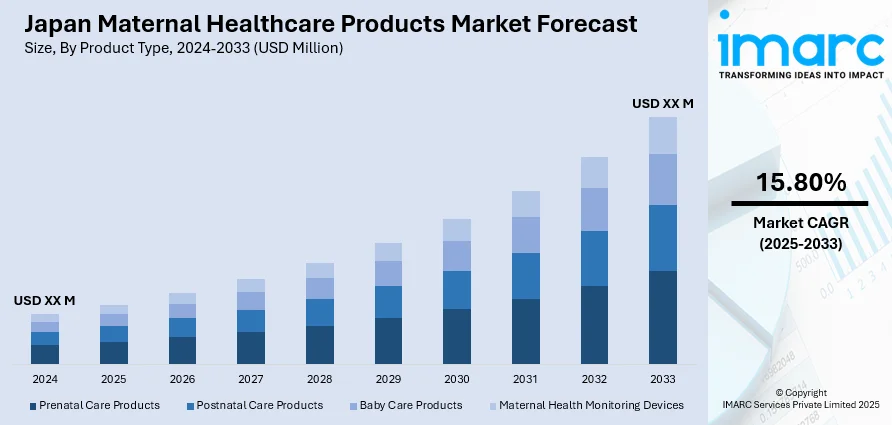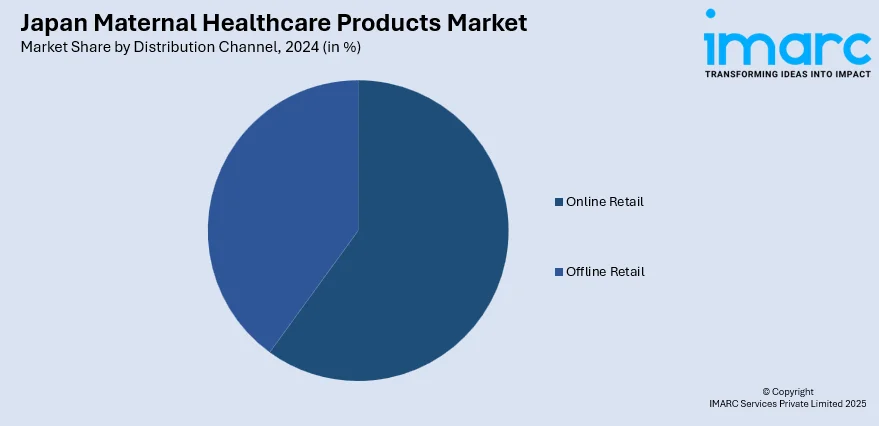
Japan Maternal Healthcare Products Market Size, Share, Trends and Forecast by Product Type, Distribution Channel, End-User, and Region, 2025-2033
Japan Maternal Healthcare Products Market Overview:
The Japan maternal healthcare products market size is projected to exhibit a growth rate (CAGR) of 15.80% during 2025-2033. At present, healthcare providers and parenting resources assist in spreading awareness about the significance of maternal health in child development, motivating women to employ improved self-care practices. In addition, the growing preferences for natural, gentle, and clinically approved healthcare solutions are positively influencing the market. Besides this, the broadening of e-commerce portals is contributing to the expansion of the Japan maternal healthcare products market share.
|
Report Attribute
|
Key Statistics
|
|---|---|
|
Base Year
|
2024
|
|
Forecast Years
|
2025-2033
|
|
Historical Years
|
2019-2024
|
| Market Growth Rate (2025-2033) | 15.80% |
Japan Maternal Healthcare Products Market Trends:
Growing focus on infant and maternal wellbeing
Rising focus on infant and maternal healthcare is positively influencing the market in Japan. According to the IMARC Group, the Japan mother and child healthcare market size reached USD 53.37 Billion in 2024. As families are becoming more health-conscious and informed, there is a greater emphasis on ensuring the safety, nutrition, and comfort of both mother and baby. Expectant mothers are actively seeking products that support a healthy pregnancy, such as prenatal vitamins, nutritional supplements, maternity skincare, and body support products. Postnatal care has also become a priority, with the growing use of items like nursing aids, stretch mark creams, and postpartum recovery solutions. Healthcare professionals and parenting resources aid in spreading awareness about the importance of maternal health in child development, encouraging women to adopt better self-care routines. Moreover, government and healthcare institutions are promoting maternal well-being through educational campaigns and support services, further driving product demand. The declining birth rate in Japan is shifting attention to improving the quality of care rather than quantity, making each pregnancy more significant in terms of medical and consumer attention. This mindset is leading to higher spending on premium, safe, and reliable maternal care products. With the rising preferences for natural, gentle, and clinically approved solutions, the market is responding with innovations that address both physical and emotional needs, ensuring healthier outcomes for mothers and infants.

To get more information on this market, Request Sample
Expansion of e-commerce portals
The expansion of e-commerce sites is impelling the Japan maternal healthcare products market growth. Online platforms offer the convenience of shopping from home, which is especially valuable for pregnant women and mothers with young children who may find it difficult to visit physical stores. E-commerce allows users to explore and compare various brands, read reviews, and make knowledgeable choices about prenatal vitamins, maternity wear, nursing accessories, and baby care products. The digital space also supports discreet purchases, which many women prefer for personal care items. With attractive discounts, subscription models, and home delivery services, online shopping is becoming a reliable option for regular healthcare needs. In addition, local and international brands are using e-commerce channels to introduce innovative products, expanding the market’s variety and quality. The rise of mobile shopping apps and targeted advertising is further enhancing user engagement. As digital literacy and smartphone utilization are increasing, women are turning to online platforms for information and purchases, making e-commerce a key growth channel for maternal healthcare products in Japan. As per industry reports, the e-commerce sector in Japan is projected to increase by 7.7% in 2025, attaining USD 206.8 Billion (JPY29 Trillion).
Japan Maternal Healthcare Products Market Segmentation:
IMARC Group provides an analysis of the key trends in each segment of the market, along with forecasts at the country and regional levels for 2025-2033. Our report has categorized the market based on product type, distribution channel, and end-user.
Product Type Insights:
- Prenatal Care Products
- Prenatal Vitamins and Supplements
- Pregnancy Tests
- Maternity Belts and Support Products
- Postnatal Care Products
- Postnatal Recovery Kits
- Breastfeeding
- Postnatal Supplements
- Baby Care Products
- Baby Skincare Products
- Baby Feeding Products
- Baby Hygiene Products
- Maternal Health Monitoring Devices
- Blood Pressure Monitors
- Glucose Monitors
- Fetal Dopplers
The report has provided a detailed breakup and analysis of the market based on the product type. This includes prenatal care products (prenatal vitamins and supplements, pregnancy tests, and maternity belts and support products), postnatal care products (postnatal recovery kits, breastfeeding, and postnatal supplements), baby care products (baby skincare products, baby feeding products, and baby hygiene products), and maternal health monitoring devices (blood pressure monitors, glucose monitors, and fetal dopplers).
Distribution Channel Insights:

- Online Retail
- Offline Retail
A detailed breakup and analysis of the market based on the distribution channel have also been provided in the report. This includes online retail and offline retail.
End-User Insights:
- Hospitals and Clinics
- Homecare Settings
- Maternity Centers
A detailed breakup and analysis of the market based on the end-user have also been provided in the report. This includes hospitals and clinics, homecare settings, and maternity centers.
Regional Insights:
- Kanto Region
- Kansai/Kinki Region
- Central/ Chubu Region
- Kyushu-Okinawa Region
- Tohoku Region
- Chugoku Region
- Hokkaido Region
- Shikoku Region
The report has also provided a comprehensive analysis of all the major regional markets, which include Kanto Region, Kansai/Kinki Region, Central/Chubu Region, Kyushu-Okinawa Region, Tohoku Region, Chugoku Region, Hokkaido Region, and Shikoku Region.
Competitive Landscape:
The market research report has also provided a comprehensive analysis of the competitive landscape. Competitive analysis such as market structure, key player positioning, top winning strategies, competitive dashboard, and company evaluation quadrant has been covered in the report. Also, detailed profiles of all major companies have been provided.
Japan Maternal Healthcare Products Market News:
- In March 2025, the government concluded a 27.3 Billion grant agreement with Japan via the Japan International Cooperation Agency (JICA) to finance the upgrade of medical equipment aimed at improving maternal and child health care services. The funding enabled the acquisition of enhanced medical equipment, boosting the ability for examination, diagnosis, and treatment at seven regional referral hospitals.
- In December 2024, MEDIROM Healthcare Technologies Inc. reported that its subsidiary MEDIROM MOTHER Labs Inc. secured orders exceeding 25,000 units of the MOTHER Bracelet, with orders from Japanese firms like NFES Technologies Inc. MEDIROM anticipated that its varied health-focused products and services would assist in gathering and managing healthcare data from users and customers, positioning it as a leader in big data within the healthcare sector.
Japan Maternal Healthcare Products Market Report Coverage:
| Report Features | Details |
|---|---|
| Base Year of the Analysis | 2024 |
| Historical Period | 2019-2024 |
| Forecast Period | 2025-2033 |
| Units | Million USD |
| Scope of the Report |
Exploration of Historical Trends and Market Outlook, Industry Catalysts and Challenges, Segment-Wise Historical and Future Market Assessment:
|
| Product Types Covered |
|
| Distribution Channels Covered | Online Retail, Offline Retail |
| End-Users Covered | Hospitals and Clinics, Homecare Settings, Maternity Centers |
| Regions Covered | Kanto Region, Kansai/Kinki Region, Central/Chubu Region, Kyushu-Okinawa Region, Tohoku Region, Chugoku Region, Hokkaido Region, Shikoku Region |
| Customization Scope | 10% Free Customization |
| Post-Sale Analyst Support | 10-12 Weeks |
| Delivery Format | PDF and Excel through Email (We can also provide the editable version of the report in PPT/Word format on special request) |
Key Questions Answered in This Report:
- How has the Japan maternal healthcare products market performed so far and how will it perform in the coming years?
- What is the breakup of the Japan maternal healthcare products market on the basis of product type?
- What is the breakup of the Japan maternal healthcare products market on the basis of distribution channel?
- What is the breakup of the Japan maternal healthcare products market on the basis of end-user?
- What is the breakup of the Japan maternal healthcare products market on the basis of region?
- What are the various stages in the value chain of the Japan maternal healthcare products market?
- What are the key driving factors and challenges in the Japan maternal healthcare products market?
- What is the structure of the Japan maternal healthcare products market and who are the key players?
- What is the degree of competition in the Japan maternal healthcare products market?
Key Benefits for Stakeholders:
- IMARC’s industry report offers a comprehensive quantitative analysis of various market segments, historical and current market trends, market forecasts, and dynamics of the Japan maternal healthcare products market from 2019-2033.
- The research report provides the latest information on the market drivers, challenges, and opportunities in the Japan maternal healthcare products market.
- Porter's five forces analysis assist stakeholders in assessing the impact of new entrants, competitive rivalry, supplier power, buyer power, and the threat of substitution. It helps stakeholders to analyze the level of competition within the Japan maternal healthcare products industry and its attractiveness.
- Competitive landscape allows stakeholders to understand their competitive environment and provides an insight into the current positions of key players in the market.
Need more help?
- Speak to our experienced analysts for insights on the current market scenarios.
- Include additional segments and countries to customize the report as per your requirement.
- Gain an unparalleled competitive advantage in your domain by understanding how to utilize the report and positively impacting your operations and revenue.
- For further assistance, please connect with our analysts.
 Request Customization
Request Customization
 Speak to an Analyst
Speak to an Analyst
 Request Brochure
Request Brochure
 Inquire Before Buying
Inquire Before Buying




.webp)




.webp)












